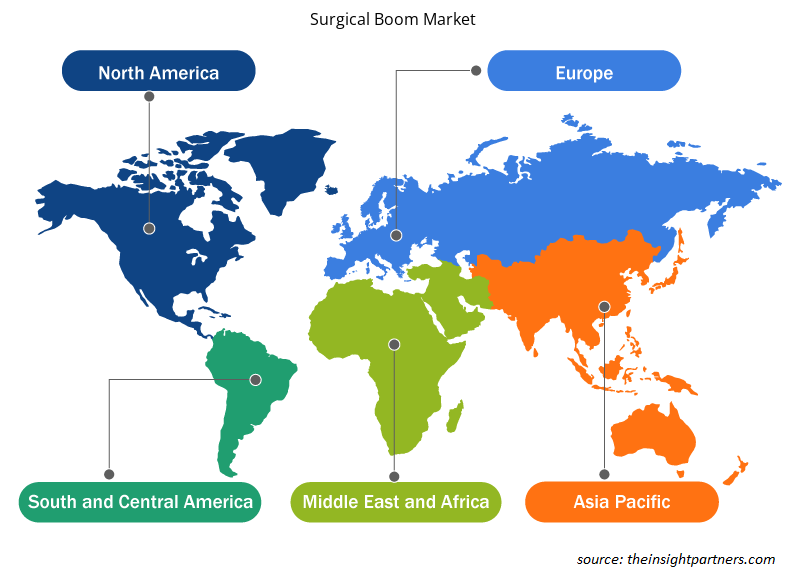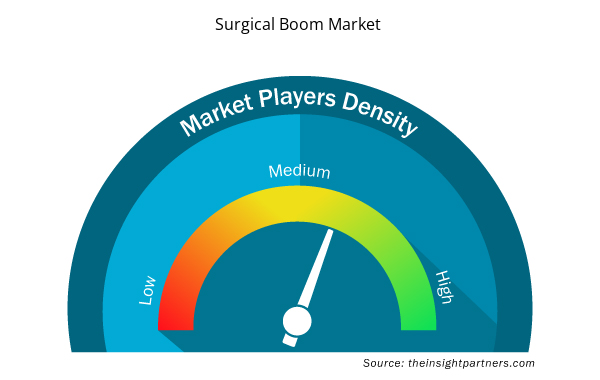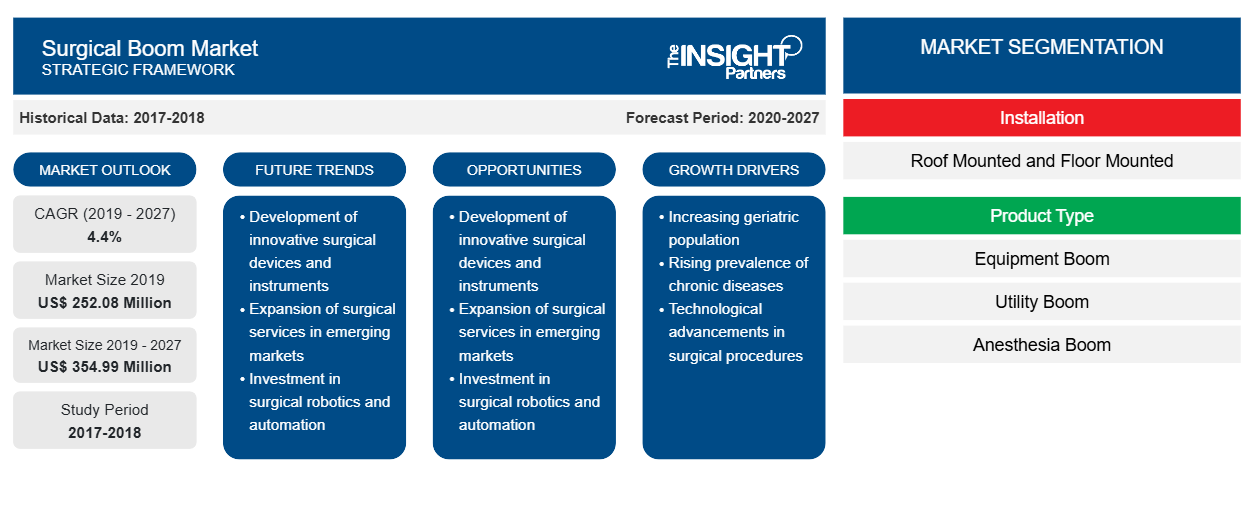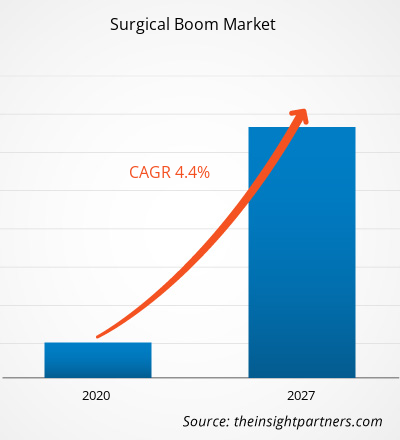Il mercato della chirurgia in forte espansione è stato valutato 252,08 milioni di dollari nel 2019 e si prevede che raggiungerà i 354,99 milioni di dollari entro il 2027; si prevede una crescita a un CAGR del 4,4% dal 2020 al 2027.
I bracci chirurgici, noti anche come colonne per apparecchiature o teste di alimentazione, sono installati nelle strutture sanitarie in quanto forniscono un facile accesso all'energia elettrica; servizi di dati audiovisivi; e gas medicali come ossigeno, azoto e anidride carbonica. I bracci riducono l'ingombro causato dai cavi e quindi eliminano il rischio di inciampo. Hanno anche ripiani che aiutano a organizzare e centralizzare le apparecchiature chirurgiche. Il numero crescente di interventi chirurgici e i vantaggi dei bracci chirurgici come flessibilità, maggiore sicurezza e mobilità sono i principali fattori che spingono la crescita del mercato. Tuttavia, il funzionamento problematico dei bracci chirurgici nelle sale operatorie ibride limita la crescita del mercato.
Personalizza questo report in base alle tue esigenze
Riceverai la personalizzazione gratuita di qualsiasi report, comprese parti di questo report, o analisi a livello nazionale, pacchetto dati Excel, oltre a usufruire di grandi offerte e sconti per start-up e università
- Scopri le principali tendenze di mercato in questo rapporto.Questo campione GRATUITO includerà analisi di dati che spaziano dalle tendenze di mercato alle stime e alle previsioni.
Approfondimenti di mercato
Aumento del numero di interventi chirurgici
L'impennata del numero di ricoveri ospedalieri dovuta all'aumento della popolazione geriatrica, alla crescente prevalenza di malattie croniche e all'aumento del numero di incidenti, tra gli altri, ha portato a un aumento del numero di interventi chirurgici. Secondo la Lifespan Organization, le malattie cardiovascolari sono la principale causa di morte negli Stati Uniti e ogni anno vengono eseguiti circa 500.000 interventi chirurgici a cielo aperto. L'aumento del numero di incidenti e casi di trauma è un altro fattore che aumenta il numero di interventi chirurgici eseguiti in tutto il mondo. I dipartimenti di pronto soccorso (A&E) in Inghilterra hanno segnalato circa 70.231 visite di pazienti al giorno nel 2019, ovvero il 4,8% in più rispetto al conteggio registrato nel 2018.
I progressi tecnologici stanno consentendo a vari ospedali e istituti medici di eseguire un gran numero di interventi chirurgici in un anno. Ad esempio, il Chang Gung Memorial Hospital di Taiwan esegue circa 167.000 interventi chirurgici in un anno e afferma di aver eseguito il numero più alto di interventi chirurgici al mondo. Inoltre, nel 2018, l'All India Institute of Medical Sciences (AIIMS) ha eseguito il numero massimo di interventi chirurgici, ovvero circa 194.000 interventi chirurgici.
Introduzione Iniziative governative per promuovere la modernizzazione dell'assistenza sanitaria
Le autorità governative nei paesi sviluppati e in via di sviluppo si stanno concentrando sul rafforzamento del loro settore sanitario attraverso investimenti significativi. Ad esempio, il governo indiano, nell'ambito del suo Pradhan Mantri Swasthya Suraksha Yojana, ha stanziato 84.221.420 USD (620 crore di rupie indiane) per la costruzione di istituzioni simili all'AIIMS e 27.168.200 USD (200 crore di rupie indiane) per l'acquisto di attrezzature mediche per l'istituzione di sale operatorie modulari. Secondo Invest India, il settore ospedaliero in India rappresenta l'80% del suo mercato sanitario totale e sta effettivamente attraendo investitori sia globali che nazionali. Si prevede che il settore ospedaliero nel paese raggiungerà i 132 miliardi di dollari entro il 2023 dai 61,8 miliardi di dollari del 2017 a un CAGR del 16-17%. Allo stesso modo, molti investimenti sanitari vengono effettuati in Polonia. La città di Cracovia in Polonia ha investito in tre ospedali per espandere i propri servizi. Con questi fondi il centro di riabilitazione e ortopedia di Cracovia mira a creare tre nuove sale operatorie, una sala di risveglio, una banca del sangue e alcune nuove stanze per i pazienti. L'aumento di tali attività governative sta creando opportunità di crescita vitali per gli operatori del mercato del boom chirurgico per garantire la crescita nei prossimi anni.
Approfondimenti basati sull'installazione
In base all'installazione, il mercato dei bracci chirurgici è segmentato in montati sul tetto e montati sul pavimento. Il segmento montato sul tetto ha detenuto una quota maggiore del mercato nel 2019 e si prevede che il segmento montato sul pavimento registrerà un CAGR più elevato del 4,8% durante il periodo di previsione. I bracci montati sul tetto sono ideali per la fornitura di elettricità e gas medicali. I bracci montati sul tetto consentono una facile fornitura e rimozione di gas medicali in base alle esigenze dell'ospedale.
Informazioni basate sul tipo di prodotto
In base al tipo di prodotto, il mercato dei bracci chirurgici è suddiviso in braccio per attrezzature, braccio per servizi di pubblica utilità, braccio per anestesia e braccio personalizzato. Il segmento dei bracci per servizi di pubblica utilità ha detenuto la quota di mercato maggiore nel 2019 e si prevede che il segmento dei bracci per anestesia registrerà il CAGR più elevato del 5,9% durante il periodo di previsione. I bracci per servizi di pubblica utilità sono dotati di un braccio flessibile con connessioni per fornire servizi di pubblica utilità come video/dati, gas ed elettricità in campi sterilizzati. Riduce il rischio di inciampo causato da cavi e fili. STERIS plc. offre HarmonyAIR Utility Hub con un braccio flessibile che fornisce alimentazione, segnale dati/video e connessioni per gas; l'attrezzatura è installata come supporto singolo o in tandem con luci chirurgiche.
Le strategie di lancio e di espansione dei prodotti sono comunemente adottate dalle aziende per espandere la propria presenza in tutto il mondo, soddisfare la crescente domanda espandendo il proprio portafoglio prodotti. I principali attori che operano nel mercato del boom chirurgico hanno adottato la strategia delle innovazioni di prodotto per soddisfare la domanda mutevole dei clienti in tutto il mondo, il che consente anche agli attori di mantenere il proprio marchio a livello globale.
Approfondimenti regionali sul mercato chirurgico in forte espansione
Le tendenze regionali e i fattori che influenzano il Surgical Boom Market durante il periodo di previsione sono stati ampiamente spiegati dagli analisti di Insight Partners. Questa sezione discute anche i segmenti e la geografia del Surgical Boom Market in Nord America, Europa, Asia Pacifico, Medio Oriente e Africa e Sud e Centro America.

- Ottieni i dati specifici regionali per il mercato del boom chirurgico
Ambito del rapporto sul mercato del boom chirurgico
| Attributo del report | Dettagli |
|---|---|
| Dimensioni del mercato nel 2019 | 252,08 milioni di dollari USA |
| Dimensioni del mercato entro il 2027 | 354,99 milioni di dollari USA |
| CAGR globale (2019 - 2027) | 4,4% |
| Dati storici | 2017-2018 |
| Periodo di previsione | 2020-2027 |
| Segmenti coperti | Per installazione
|
| Regioni e Paesi coperti | America del Nord
|
| Leader di mercato e profili aziendali chiave |
|
Densità degli attori del mercato del boom chirurgico: comprendere il suo impatto sulle dinamiche aziendali
Il mercato del Surgical Boom Market sta crescendo rapidamente, spinto dalla crescente domanda degli utenti finali dovuta a fattori quali l'evoluzione delle preferenze dei consumatori, i progressi tecnologici e una maggiore consapevolezza dei benefici del prodotto. Con l'aumento della domanda, le aziende stanno ampliando le loro offerte, innovando per soddisfare le esigenze dei consumatori e capitalizzando sulle tendenze emergenti, il che alimenta ulteriormente la crescita del mercato.
La densità degli operatori di mercato si riferisce alla distribuzione di aziende o società che operano in un particolare mercato o settore. Indica quanti concorrenti (operatori di mercato) sono presenti in un dato spazio di mercato in relazione alle sue dimensioni o al valore di mercato totale.
Le principali aziende che operano nel mercato chirurgico in forte espansione sono:
- Società STERIS
- CORPORAZIONE STRYKER
- AMICO
- GRUPPO GETINGE
- Società per azioni Dragerwerk AG & Co. KGaA
Disclaimer : le aziende elencate sopra non sono classificate secondo un ordine particolare.

- Ottieni una panoramica dei principali attori del mercato Surgical Boom
Per installazione
- Montato sul tetto
- Montato a pavimento
Per tipo di prodotto
- Boom delle attrezzature
- Boom dei servizi di pubblica utilità
- Boom dell'anestesia
- Boom personalizzato
Da parte dell'utente finale
- Ospedali
- Centri chirurgici ambulatoriali
- Altri
Per Geografia
- America del Nord
- NOI
- Canada
- Messico
- Europa
- Francia
- Germania
- Italia
- Regno Unito
- Spagna
- Asia Pacifico (APAC)
- Cina
- India
- Corea del Sud
- Giappone
- Australia
- Medio Oriente e Africa (MEA)
- Sudafrica
- Arabia Saudita
- Emirati Arabi Uniti
- America del Sud e Centro (SCAM)
- Brasile
- Argentina
Profili aziendali
- Società Steris
- Società per azioni Stryker
- Amico
- Gruppo Getinge
- Società per azioni Dragerwerk AG & Co. KGaA
- Cielotron
- CV medico
- Medicina
- Collina
- Shenzhen Mindray Bio Medical Electronics Co., Ltd
- Analisi storica (2 anni), anno base, previsione (7 anni) con CAGR
- Analisi PEST e SWOT
- Valore/volume delle dimensioni del mercato - Globale, regionale, nazionale
- Industria e panorama competitivo
- Set di dati Excel



Report Coverage
Revenue forecast, Company Analysis, Industry landscape, Growth factors, and Trends

Segment Covered
This text is related
to segments covered.

Regional Scope
North America, Europe, Asia Pacific, Middle East & Africa, South & Central America

Country Scope
This text is related
to country scope.
Domande frequenti
The surgical boom market majorly consists of the players such Steris Corporation, Stryker Corporation, Amico, Getinge Group, Dräger, Skytron, C V Medical, Medicana, Hillrom, Shenzhen Mindray Bio Medical Electronics Co., Ltd among others.
The factors that are driving growth of the market are increasing number of surgeries, and the benefits of surgical booms such as flexibility, enhanced safety, and mobility.
Surgical booms, also known as equipment columns or supply heads, are installed in healthcare facilities as they provide easy access to electrical power; audiovisual data services; and medical gasses such as oxygen, nitrogen, and carbon dioxide. Booms reduce the clutter caused by the cords and thus eliminate the risk of tripping hazards. They also have shelves that help in organizing and centralizing surgical equipment.
Trends and growth analysis reports related to Life Sciences : READ MORE..
The List of Companies - Surgical Boom Market
- STERIS CORPORATION
- STRYKER CORPORATION
- AMICO
- GETINGE GROUP
- Dragerwerk AG & Co. KGaA
- SKYTRON
- C V MEDICAL
- Shenzhen Mindray Bio Medical Electronics Co., Ltd.
- MEDICANA
- HILLROM
The Insight Partners performs research in 4 major stages: Data Collection & Secondary Research, Primary Research, Data Analysis and Data Triangulation & Final Review.
- Data Collection and Secondary Research:
As a market research and consulting firm operating from a decade, we have published and advised several client across the globe. First step for any study will start with an assessment of currently available data and insights from existing reports. Further, historical and current market information is collected from Investor Presentations, Annual Reports, SEC Filings, etc., and other information related to company’s performance and market positioning are gathered from Paid Databases (Factiva, Hoovers, and Reuters) and various other publications available in public domain.
Several associations trade associates, technical forums, institutes, societies and organization are accessed to gain technical as well as market related insights through their publications such as research papers, blogs and press releases related to the studies are referred to get cues about the market. Further, white papers, journals, magazines, and other news articles published in last 3 years are scrutinized and analyzed to understand the current market trends.
- Primary Research:
The primarily interview analysis comprise of data obtained from industry participants interview and answers to survey questions gathered by in-house primary team.
For primary research, interviews are conducted with industry experts/CEOs/Marketing Managers/VPs/Subject Matter Experts from both demand and supply side to get a 360-degree view of the market. The primary team conducts several interviews based on the complexity of the markets to understand the various market trends and dynamics which makes research more credible and precise.
A typical research interview fulfils the following functions:
- Provides first-hand information on the market size, market trends, growth trends, competitive landscape, and outlook
- Validates and strengthens in-house secondary research findings
- Develops the analysis team’s expertise and market understanding
Primary research involves email interactions and telephone interviews for each market, category, segment, and sub-segment across geographies. The participants who typically take part in such a process include, but are not limited to:
- Industry participants: VPs, business development managers, market intelligence managers and national sales managers
- Outside experts: Valuation experts, research analysts and key opinion leaders specializing in the electronics and semiconductor industry.
Below is the breakup of our primary respondents by company, designation, and region:

Once we receive the confirmation from primary research sources or primary respondents, we finalize the base year market estimation and forecast the data as per the macroeconomic and microeconomic factors assessed during data collection.
- Data Analysis:
Once data is validated through both secondary as well as primary respondents, we finalize the market estimations by hypothesis formulation and factor analysis at regional and country level.
- Macro-Economic Factor Analysis:
We analyse macroeconomic indicators such the gross domestic product (GDP), increase in the demand for goods and services across industries, technological advancement, regional economic growth, governmental policies, the influence of COVID-19, PEST analysis, and other aspects. This analysis aids in setting benchmarks for various nations/regions and approximating market splits. Additionally, the general trend of the aforementioned components aid in determining the market's development possibilities.
- Country Level Data:
Various factors that are especially aligned to the country are taken into account to determine the market size for a certain area and country, including the presence of vendors, such as headquarters and offices, the country's GDP, demand patterns, and industry growth. To comprehend the market dynamics for the nation, a number of growth variables, inhibitors, application areas, and current market trends are researched. The aforementioned elements aid in determining the country's overall market's growth potential.
- Company Profile:
The “Table of Contents” is formulated by listing and analyzing more than 25 - 30 companies operating in the market ecosystem across geographies. However, we profile only 10 companies as a standard practice in our syndicate reports. These 10 companies comprise leading, emerging, and regional players. Nonetheless, our analysis is not restricted to the 10 listed companies, we also analyze other companies present in the market to develop a holistic view and understand the prevailing trends. The “Company Profiles” section in the report covers key facts, business description, products & services, financial information, SWOT analysis, and key developments. The financial information presented is extracted from the annual reports and official documents of the publicly listed companies. Upon collecting the information for the sections of respective companies, we verify them via various primary sources and then compile the data in respective company profiles. The company level information helps us in deriving the base number as well as in forecasting the market size.
- Developing Base Number:
Aggregation of sales statistics (2020-2022) and macro-economic factor, and other secondary and primary research insights are utilized to arrive at base number and related market shares for 2022. The data gaps are identified in this step and relevant market data is analyzed, collected from paid primary interviews or databases. On finalizing the base year market size, forecasts are developed on the basis of macro-economic, industry and market growth factors and company level analysis.
- Data Triangulation and Final Review:
The market findings and base year market size calculations are validated from supply as well as demand side. Demand side validations are based on macro-economic factor analysis and benchmarks for respective regions and countries. In case of supply side validations, revenues of major companies are estimated (in case not available) based on industry benchmark, approximate number of employees, product portfolio, and primary interviews revenues are gathered. Further revenue from target product/service segment is assessed to avoid overshooting of market statistics. In case of heavy deviations between supply and demand side values, all thes steps are repeated to achieve synchronization.
We follow an iterative model, wherein we share our research findings with Subject Matter Experts (SME’s) and Key Opinion Leaders (KOLs) until consensus view of the market is not formulated – this model negates any drastic deviation in the opinions of experts. Only validated and universally acceptable research findings are quoted in our reports.
We have important check points that we use to validate our research findings – which we call – data triangulation, where we validate the information, we generate from secondary sources with primary interviews and then we re-validate with our internal data bases and Subject matter experts. This comprehensive model enables us to deliver high quality, reliable data in shortest possible time.


 Ottieni un campione gratuito per questo repot
Ottieni un campione gratuito per questo repot